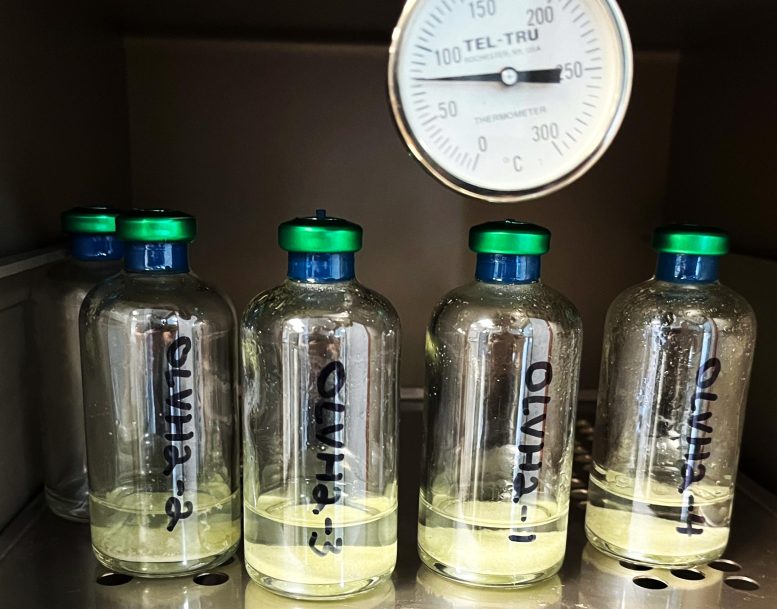
Researchers at The University of Texas at Austin are pioneering a method to produce hydrogen from iron-rich rocks without CO2 emissions, potentially revolutionizing the hydrogen industry. Credit: SciTechDaily.com
Innovative research on hydrogen production from geological sources could significantly impact the sustainable energy landscape, offering a low-carbon alternative to current methods.
In a project that could be a game changer for the energy transition, researchers at The University of Texas at Austin are exploring a suite of natural catalysts to help produce hydrogen gas from iron-rich rocks without emitting carbon dioxide.
If the scientists are successful, the project could jump-start a brand-new type of hydrogen industry: geologic hydrogen.
A Leap for the Hydrogen Industry
“We’re producing hydrogen from rocks,” said Toti Larson, a research associate professor at the UT Jackson School of Geosciences Bureau of Economic Geology and the lead researcher on the project. “It’s a type of non-fossil fuel production of hydrogen from iron-rich rocks that has never been attempted at an industrial scale.”
The research team recently received a $1.7 million grant from the Department of Energy and is collaborating with scientists at the University of Wyoming’s School of Energy Resources to explore the feasibility of this process on different rock types across the United States.

Researchers are studying chemical catalysts that can produce hydrogen gas from iron-rich rocks. Credit: Toti Larson / UT Austin
Hydrogen is an important player in the energy transition because it does not produce CO2 gas emissions when it’s burned for fuel. Its only byproduct is water. However, most hydrogen gas today is produced from natural gas in a process that also produces CO2.
Producing geologic hydrogen from iron-rich rocks would offer a major shift in the energy transition because of its low-carbon emission footprint, said Larson.
“If we could replace hydrogen that is sourced from fossil fuels with hydrogen sourced from iron-rich rocks, it will be a huge win,” Larson said
Innovations in Geologic Hydrogen Production
The catalysts the team is exploring will stimulate a natural geologic process called “serpentinization.” During serpentinization, iron-rich rocks release hydrogen as a byproduct of chemical reactions.
Serpentinization usually occurs at high temperatures. With natural catalysts that include nickel and other platinum group elements, the team is working to stimulate hydrogen production at lower temperatures and at depths easily accessible by today’s technology where iron-rich rocks are found throughout the world. That means catalyst-enhanced production of hydrogen from iron-rich rocks has the potential to significantly increase hydrogen production globally.

Esti Ukar (left) and Toti Larson are leading a project to produce geologic hydrogen from rocks. They are both researchers at the Bureau of Economic Geology, a research unit of the UT Jackson School of Geosciences. Credit: Toti Larson / UT Austin
“Natural accumulations of geologic hydrogen are being found all over the world, but in most cases they are small and not economical, although exploration continues,” said Esti Ukar, a research associate professor at the Jackson School and a collaborator on the project. “If we could help generate larger volumes of hydrogen from these rocks by driving reactions that would take several million years to happen in nature, I think geologic hydrogen could really be a game changer.”
Ukar is also leading work on another energy transition project to develop carbon-free mining techniques that store CO2 as part of the mineral extraction process.
Researchers have already conducted successful tests at the laboratory scale. The grant, from the Department of Energy Advanced Research Projects Agency-Energy (ARPA-E), will be used to scale up the experiments and test the process on a broad range of iron-rich rock types found across North America. The team will investigate using the catalysts on basalts from the Midcontinent Rift in Iowa, banded iron formations in Wyoming and ultramafic rocks in the Midwest.
This project is one of several research initiatives at the Bureau of Economic Geology investigating the role of the subsurface in the generation and storage of hydrogen as part of the energy transition.









This is only part of the problem. We still haven’t solved the problem of embrittlement of steel storage tanks, supply lines, and valves. If used as fuel in internal combustion engines, then the cylinders, rings, and cylinder walls will have reduced lifetimes with possible catastrophic failures resulting from embrittlement.
While rarely acknowledged by alarmists, water vapor is a more powerful ‘greenhouse gas’ than CO2. It is rationalized that water vapor isn’t important because it precipitates out in a few days and is part of the natural cycles. If the water vapor is released into the atmosphere then it can result in warming, just like CO2, and will be replenished continuously 24/7/365. However, if it is purposely created by humans, then it has to be considered anthropogenic. The water vapor could be condensed and carried on board vehicles, but that would result in reduced efficiency from the added weight. Also, it would require additional attention from owners to release the water periodically. There may be issues resulting from the fact that water is a ‘universal solvent’ whose ability to dissolve things is enhanced when it is pure. There may be unintended consequences from releasing large quantities of distilled water into drains continuously.
Then there is the economics. Whether the rocks are blasted, comminuted, and hauled to a chemical factory, or a potential source rock is fractured with explosives and the hydrogen is produced in situ, CO2 will be released.
The problem has to be examined from a holistic viewpoint, not just from the viewpoint of whether the chemistry allows it.
Clearly not a “renewable” resource even if it doesn’t emit CO2.
Gotta say it feels weird to be using solvents on rock, catalyst or not, but that -releasing water- take, extracting rock without wanting the aggregate (v. just running ops downbore) and missing DARPA’s high-entropy materials ventures are bad takes (though the lifetime of the metals is still 35 Y without coating specially, or more if you run electrochemistry and just skip structural metals in that. No high pressure steam in fissile core, no problem?) But…this is ARPA-E.
Thank you for mentioning Hydrogen embrittlement. The clowns seem to ignore the disaster that is. They are delusional twits.
No, I think that they are just too narrowly focused on one aspect of the problem and don’t see the Big Picture.
All this expensive and heavily subsidized bizarre technology because of the consensus belief that there is some sort of catastrophic crisis and global climate emergency in our future. This technology, like most others designed to avoid CO2 emissions will need conventional vehicles for the transportation involved. That means more oil. And there is no way around it using EVs.
The irony of a climate denier commenting on an article about science.
The irony of a climate alarmist responding to a comment without citing any science to support his personal opinion.
Here is the problem with this fiel source, it will deplete atmospheric oxygen levels if we use H2 and don’t use H2O as the fuel source. Obviously, less Oxygen is not good and starting a downward trend in O2 in the atmosphere is not a good long term solution.
This article doesn’t discuss another proposed source for “Green” Hydrogen. Electrolysis using renewable electricity sources, wind power, solar power and hydro power from remote generating stations. These projects will separate Oxygen from Hydrogen by breaking apart water molecules. There will no shortage of Oxygen when the H2 fuel is burned to create water,
Perhaps we should focus on geological molecular H2 in carbon shale deposits catalyzed for low energy nuclear power systems, engineering dense hydrogen energy-based systems by Subtle Atomics, look it up.
I’m reminded of the former practice of ‘salting’ a gold mine by replacing the lead pellets in a shotgun shell with small gold nuggets and firing the load into a barren mine tunnel to give some rich dupe the impression that it is a rich gold mine. Pretty pictures don’t cut it alone.